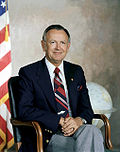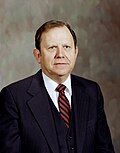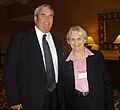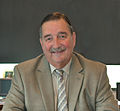| Year | Recipient | Recipient department when received award | Recipient position when received award | Note |
|---|
| 1978 |  | Norman Carlson | United States Department of Justice | Director of the Bureau of Prisons | [1] |
| Edwin C. Kilgore | National Aeronautics and Space Administration | Director of Management Operation, Langley Research Center | [1] |
| 1979 |  | Christopher C. Kraft | National Aeronautics and Space Administration | Director, Lyndon B. Johnson Space Center | [7] |
| Dale R. McOmber | Office of Management and Budget | Assistant Director, Budget Review | |
| 1980 |  | Harry S. Havens | General Accounting Office | Assistant Comptroller General for Program Evaluation | [8] |
 | Francis J. Mulhern | United States Department of Agriculture | Administrator of the Animal and Plant Health Inspection Service | |
| 1981 |  | William R. Lucas | National Aeronautics and Space Administration | Marshall Flight Center, Director | [2] |
| Charles V. Yarbrough | United States Veterans Administration | Director, Management Support | [2] |
| 1982 | | G. Phillips Hanna | Office of Management and Budget | Deputy Division Chief for Human Resources, Veterans, and Labor | [9] |
| William C. Watson Jr. | United States Department of Health and Human Services | Deputy Director, Centers for Disease Control | [10] |
| 1983 |  | David O. Cooke | United States Department of Defense | Deputy Assistant Secretary of Defense for Administration | [11] |
| Joyce J. Walker | Office of Management and Budget | Deputy Associate Director for Transportation, Commerce, and Housing | |
| 1984 | | Stanley Goldberg | United States Department of the Treasury | Assistant Commissioner, Returns and Information Processing, Internal Revenue Service | |
| Gerald J. Mossinghoff | United States Postal Service | Assistant Secretary and Commissioner for Patents and Trademarks | [12] |
| 1985 | | Robert L. Trachtenberg | United States Department of Health and Human Services | Deputy Administrator, Alcohol, Drug Abuse, and Mental Health Administration | [13] |
 | Robert J. Eichelberger | United States Department of the Army | Director, U.S. Army Ballistic Research Laboratory | [14] |
| 1986 | | William E. Douglas | United States Department of the Treasury | Commissioner, Financial Management Service | [15] |
 | Earle L. Messere | United States Navy | Technical Director, Naval Underwater Systems Center, Newport | [16] |
| 1987 | | John R. Simpson | United States Department of the Treasury | Director, U.S. Secret Service, and President of INTERPOL | [17] |
| Milton J. Socolar | General Accounting Office | Special Assistant to the Comptroller General | [18] |
| 1988 | | Vernon N. Houk | United States Department of Health and Human Services | Director, Center for Environmental Health and Injury Control, Centers for Disease Control | |
| Raymond G. Kammer | United States Department of Commerce | Deputy Director, National Bureau of Standards | [19] |
| 1989 | | Joseph R. Caraveo | United States Postal Service | Regional Postmaster General, Western Region | |
 | Richard A. Clarke | United States Department of State | Deputy Assistant Secretary for Regional Affairs, Bureau of Intelligence and Research | |
| 1990 | | James L. Blum | Congressional Budget Office | Assistant Director for Budget Analysis | [20] |
| Stephen E. Higgins | United States Department of the Treasury | Director, Bureau of Alcohol, Tobacco, and Firearms | [21] |
| 1991 | | Thomas S. McFee | United States Department of Health and Human Services | Assistant Secretary for Personnel Administration | [22] |
 | Joseph L. Moore | United States Department of Veterans Affairs | Director, Veterans Affairs Medical Center, Chicago | |
| 1992 |  | Aaron Cohen | National Aeronautics and Space Administration | Director, Lyndon B. Johnson Space Center | [23] |
| J. Dexter Peach | General Accounting Office | Assistant Comptroller General, Resources, Community, and Economic Development Program | [24] |
| 1993 |  | Walter Dowdle | United States Department of Health and Human Services | Deputy Director, Centers for Disease Control | |
| Eva C. Ugarkovich | United States Air Force | Director of Financial Management | |
| 1994 | | James J. Devine | National Security Agency | Deputy Director for Support Services | |
 | Ruth Kirschstein | United States Department of Health and Human Services | Deputy Director, National Institutes of Health | [25] |
| 1995 | | Joan Dempsey | United States Department of Defense | Director, National Military Intelligence Production Center | [26] |
| Janet Shikles | General Accounting Office | Assistant Comptroller General for Health, Education, and Human Services | [27] |
| 1996 | | Frank Almaguer | United States Agency for International Development | Deputy Assistant Administrator for Human Resources | [28] |
| Nancy George | United States Postal Service | Vice President for the Northeast Area | [29] |
| 1997 | | John Dyer | Social Security Administration | Acting Principal Deputy Commissioner | |
 | J. Wayne Littles | National Aeronautics and Space Administration | Director, George C. Marshall Space Flight Center | [30] |
| 1998 | | Virginia S. Bales | United States Department of Health and Human Services | Deputy Director, National Center for Chronic Disease Prevention and Health Promotion, Centers for Disease Control | |
| William J. Henderson | United States Postal Service | Executive Vice President and Chief Operating Officer | [31] |
| 1999 | | John E. Sirmalis | United States Navy | Technical Director, Naval Undersea Warfare Center | [32] |
| Robert S. Winokur | National Oceanic and Atmospheric Administration | Assistant Administrator for Satellite and Information Services | [33] |
| 2000 |  | Charles P. Nemfakos | United States Navy | Deputy Under Secretary for Institutional Strategic Planning | [34] |
| Janet Woodcock | United States Department of Health and Human Services | Director, Center of Drug Evaluation and Research Food and Drug Administration | [35] |
| 2001 | | Paul D. Barnes | Social Security Administration | Deputy Commissioner for Human Resources | [36] |
| Arthur J. Murton | Federal Deposit Insurance Corporation | Director, Division of Insurance | [37] [38] |
| 2002 | | Victor J. Ferlise | United States Army | Deputy to the Commanding General, Communications Electronic Command | [6] [39] |
| Kenneth M. Pusateri | Defense Nuclear Facilities Safety Board | General Manager | [40] |
| 2003 | | Larry G. Massanari | Social Security Administration | Regional Commissioner | [41] |
| James Randolph Farris | United States Department of Health and Human Services | Centers for Medicare and Medicaid Services, Regional Administrator | [42] |
| 2004 |  | Jennifer C. Buck | United States Department of Defense | Deputy Assistant Secretary of Defense for Reserve Affairs | [43] |
 | Michael J. Zamorski | Federal Deposit Insurance Corporation | Director, Division of Supervision and Consumer Protection | [37] [44] |
| 2005 |  | Sheila M. Earle | Office of the Secretary of Defense | Acting Principal Director for Military Personnel Policy | [45] |
| Marvin E. Gunn Jr. | United States Department of Energy | Manager of the Office of Science, Chicago Office | [45] |
| 2006 |  | David M. Altwegg | Office of the Secretary of Defense | Deputy for Agency Operations, Missile Defense Agency | [46] [47] |
 | William H. Gimson III | United States Department of Health and Human Services | Chief Operating Officer, Centers for Disease Control and Prevention | [46] |
| 2007 |  | MaryAnn Musumeci | United States Department of Veterans Affairs | Director, James J. Peters Veterans Affairs Medical Center, The Bronx | [48] [49] |
 | John E. Potter | United States Postal Service | Postmaster General and chief executive officer | |
| 2008 |  | Thomas A. Betro | United States Department of the Navy | Director, Naval Criminal Investigative Service | [50] |
 | Theresa M. Whelan | United States Department of Defense | Deputy Assistant Secretary of Defense for African Affairs | [50] |
| 2009 |  | Gene L. Dodaro | Government Accountability Office | Comptroller General of the United States | [51] |
| Linda E. Stiff | United States Department of the Treasury | Deputy Commissioner for Services and Enforcement, Internal Revenue Service | [51] |
| 2010 |  | Kenneth E. Baker | United States Department of Energy | Principal Assistant Deputy Administrator, National Nuclear Security Administration, Office of Defense Nuclear Nonproliferation | [52] |
 | Peggy A. Forcarino | United States Department of Commerce | Deputy Commissioner for Patents, U.S. Patent and Trademark Office | [52] |
| 2011 |  | Margaret Gilligan | Federal Aviation Administration | Associate Administrator | [53] |
 | John A. Montgomery | United States Department of the Navy | Director of Research, Naval Research Laboratory | [53] [54] |
| 2012 |  | Thomas L. Mesenbourg Jr. | United States Census Bureau | Acting Director | [55] [56] |
 | David Wennergren | United States Department of Defense | Assistant Deputy Chief Management Officer | [56] |
| 2013 |  | David A. Bray | Federal Communications Commission | Chief Information Officer | [3] |
 | Brian Persons | United States Department of the Navy | Assistant Deputy Chief of Naval Operations for Warfare Systems | [3] |
































